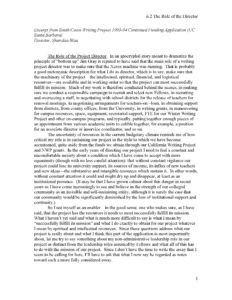One Director’s Role as Leader, Contextualizer, Researcher, Enabler, and Site Conscience
Excerpt
In an apocryphal story meant to dramatize the principle of “bottom up” Jim Gray is reputed to have said that the main role of a writing project director was to make sure that the Xerox machine was running. That is probably a good metonymic description for what I do as director, which is to say, make sure that the machinery of the project—the intellectual, spiritual, financial, and logistical resources—are available and in working order so that the project can most successfully fulfill its mission. Much of my work is therefore conducted behind the scenes, in making sure we conduct a responsible campaign to recruit and select new Fellows, in recruiting and overseeing a staff, in negotiating with school districts for the release of teachers for renewal meetings, in negotiating arrangements for teachers-on–loan, in obtaining support from districts, from county offices, from the University, in writing grants, in maneuvering for campus resources, space, equipment, secretarial support, FTE for our Winter Writing Project and other on-campus programs, and typically, putting together enough pieces of an appointment from various academic units to cobble together, for example, a position for an associate director or inservice coordinator, and so on.


